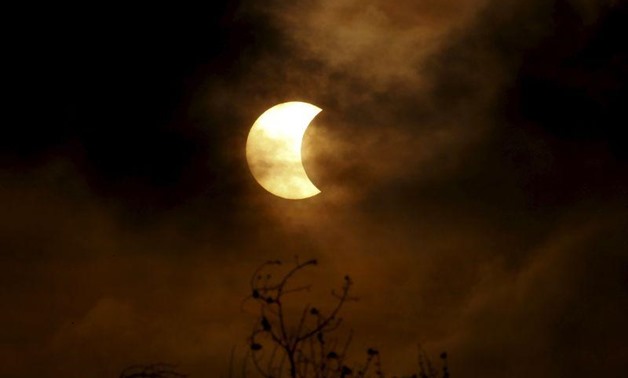
A partial solar eclipse is seen through clouds in Bangkok, Thailand, March 9, 2016. REUTERS/Chaiwat Subprasom
CAIRO – 11 August 2018: The Northern Hemisphere of the Earth is witnessing a partial eclipse of the sun on Saturday, two weeks after the longest lunar eclipse in the 21st century. The eclipse will last for three hours and 28 minutes, the third and final this year.
The Association of Astronomy in Jeddah announced that this partial eclipse, celestial event in which the moon briefly lapses with the sun, will be visible from Northern and Eastern Europe, North America, and some northern and western locations in Asia, making it the most watched solar eclipse of 2018 especially in Russia; however, it will be totally invisible in the Arab region.
"Unlike the lunar eclipse, the solar eclipse needs special monitoring equipment such as special glasses or optical filters for telescopes and binoculars for eye safety," the report stated.
The eclipse will officially begin when the moon first appears to make contact with the sun's disk at 4:02 a.m. EDT 8:02 GMT. Maximum eclipse will occur at 5:46 a.m. EDT (9:46 GMT), when the eclipse is at magnitude 0.7361.
During the solar eclipse, the moon reaches the stage of conjugation, called the "giant helix", which is 358,491 kilometers from east to west, ending its cycle around Earth and starting its new cycle.
The report declared that the moon can be called a "giant” whether it is a full or partial moon, when the distance between the center of the moon and the center of the Earth lays within a distance of 362,146 kilometers.
According to the repost, such a description lacks accuracy; yet, it has been commonly used years ago.
Accordingly, the moon will be near “perigee”, the closest point to Earth in the moon's orbit.
Solar eclipses occur when the disk of the moon appears to cross in front of the disk of the sun, while a total solar eclipse, like the one that took place on Aug. 21, 2017, occurs when the disk of the moon blocks 100 percent the solar disk. A partial eclipse occurs when the moon covers only part of the sun’s disk.
As noticed, in 2018, sky watchers in the few selected locations on Earth did have three opportunities to observe a solar eclipse. The first solar eclipse of 2018 took place on Feb. 15 and was visible only from parts of Antarctica, the Atlantic Ocean and southern South America. The second one took place on July 13 and was visible primarily over the ocean between Australia and Antarctica. The third and last one is taking place on Aug. 11 and will swing over the North Pole.
Additional reporting by Ingy Rashed


Comments
Leave a Comment